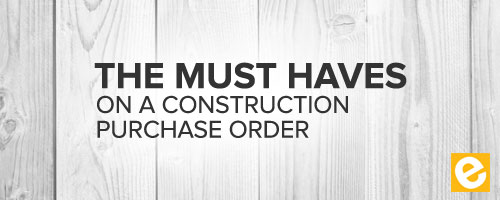
The difference between a Purchase Order and an Invoice
The difference between a Purchase Order and an Invoice
Table of Contents
What is a construction purchase order?
Construction purchase orders, or (POs), are formal documents sent from buyers to sellers that request orders for products. They can be viewed as contracts that bind the buyer and the seller through the products being sold. In commercial construction, subcontractors use purchase orders to initiate the buying process of materials. Purchase orders should be clear and follow certain criteria to be effective. The ideal purchase order should include descriptions, quantities, discounts, and prices of the product. They should also state payment terms and shipment dates.
Why are purchase orders important?
When accepted, purchase orders form legally bound contracts between the supplier and the buyer. This makes purchase orders a must have in any construction project because they serve as clear instruction for the buyer to the seller. These documents can then be used to help determine fault if a deal goes wrong. Also, they are important for sellers because if a payment is refused, the buyer is legally inclined to the stated agreement.
What is an invoice?
Also called bills, sales invoices or statements, invoices are business documents oriented around a particular transaction. An invoice can be viewed as the reciprocal of a purchase order. They include items sold, prices, date of shipment, delivery and payment terms. In some cases, an invoice is sent after the payment has been received. The function of an invoice is to indicate the money that a buyer owes to a seller, or to simply indicate that an order is confirmed and on its way.
So what is the difference?
While buyers draft purchase orders, sellers draft invoices. Both documents contain similar details, but invoices lack certain technical information that purchase orders often include such as the due date of the materials. Subcontractors use purchase orders to order goods or services, while suppliers use invoices to show when the payment is due. In sum then, purchase orders define the contract of sale, while invoices mark the confirmation of sale.
What is the relationship between invoices and purchase orders?
Either after payment is received, or in other cases after the delivery of the purchased items, invoices are prepared and then sent to buyers. Before the deal is settled, the two parties refer to both the purchase order and the invoice to ensure that the transaction went as planned.
Example:
Robert, the foreman on the job site, has been notified that he needs bolts for his upcoming project. The first thing he does is draft a purchase order specifying the quantity and type of bolts needed. He includes a detailed description of the bolts including the hex size, length and thread pattern in the purchase order, and then sends it to the supplier. After the bolt supplier receives the order and confirms that they can deliver the desired number of bolts on time, they approve the purchase order and accept the payment. The bolts are then shipped, and an invoice is sent to Robert confirming the shipment of the bolts and the acceptance of the payment. Robert then compares the purchase order and the invoice to ensure that they both match up.
Why integrate purchase orders into your business?
As stated above, both purchase orders and invoices are critical to the success of your business. They are crucial because they set the desired agreements in stone and hold companies accountable. Many construction companies perceive the material purchasing process as complex and sometimes skip the process entirely because they fear dealing with unorganized paperwork. It is important that companies continue to use purchase orders because they can show where, and if, something went wrong in the purchasing process. If no purchase order was drafted, and a buyer receives an order that does not fit the desired qualifications, both parties are put into a complicated legal situation, so it is important to have POs organized and readily available. eSUB, is a solution to help make your purchase order process manageable.
Conclusion:
It is important that subcontractors understand the differences between invoices and purchase orders so that they can use them in the most profitable manner possible. Companies should never underestimate the value of these documents if a transaction does not go as planned. With new construction software available such as eSUB, subcontractors should never fear the hassle of dealing with purchase orders and invoices again. By thoroughly understanding purchasing documents, and allowing new technology to assist, subcontractors can be more efficient and also feel more secure in their purchases.
Sources:
